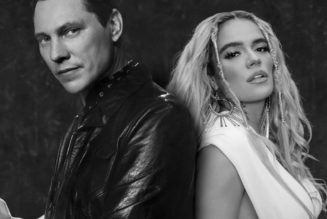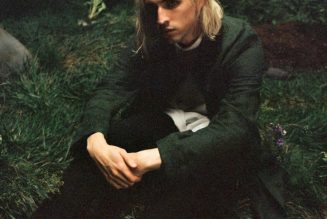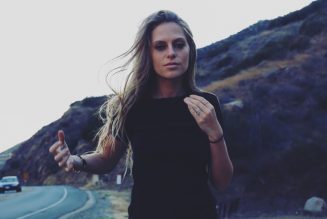For years now, Sub Focus and Wilkinson have dominated the drum & bass scene with their timeless anthems and cutting edge production. Earlier this year, the duo collaborated on three tracks—”Just Hold On,” “Illuminate,” and “Air I Breathe”—igniting the world of drum & bass and showcasing the producers’ diverse range of sounds.
In September, it was revealed that those three singles were part of something greater after the announcement of Portals, the new album from Sub Focus and Wilkinson.
Just under a month later, Portals has arrived, and fans are elated. The album explores new facets of both Sub Focus and Wilkinson via live instrumentation and experimentation with tempo, but remains unmistakably true to each artist’s sound. The duo kindly took some time to chat with EDM.com about the release of Portals.
EDM.com: How is it preparing for the release of Portals?
Wilkinson: Exciting times!
Sub Focus: Yeah, we’re excited. I think we might be getting physical copies of the LP today, Mark, which is wicked.
W: Oh, brilliant! That’s exciting.
S: I haven’t done a physical album in a while, so it’s quite exciting to get some vinyl that we actually made.
W: Yeah, something tangible.
E: It’s kind of rare these days to not only release a full length album, but on vinyl as well.
S: Yeah, I think that a lot of people have sort of been moving to releasing much more singles. But I guess we still felt that there’s something to be said for the album format. I think it’s allowed us to be more experimental than what we’d do with a single. When you’re writing one-off tracks, they have to be many things.
W: Yeah, with singles you have to try and tick lots of boxes. It needs to do everything. Whereas with an album, you have 12 or 13 tracks that you can kind of create a story with, and those tracks can be very different from one another. But they’re also tied together and form a coherent album that tells a story.
S: That’s kind of what we were going for with this album. We discovered that we liked working together through doing a single called “Take It Up” in 2018. And we were listening to a lot of the same artists, like John Hopkins, Bonobo, and the like who were writing interesting long-play albums. We thought, “Wouldn’t it be cool to do something like that in drum & bass and breakbeat?”
E: You mentioned having the room to be more experimental with the album format. Is there lots of experimental music on the album?
S: I’d say the music that’s there is very much like stuff we’ve made before, but we basically wanted to bring in a more organic sound palate. We were experimenting with tempo, but really we were just trying to be more ambitious with a long-play album. Make it not just singles, but more of a listening journey, a breadth of the styles of music we make. Everything from hard, club drum & bass to more mellow, downtempo things.
W: Most dance music is written in a computer, and a lot of the instruments you use, everyone uses. We wanted to step outside of that, use real instruments and outboard gear that isn’t typically used in modern dance music. That’s why we went to a studio called REALWORLD, which is an amazing studio that’s just got lots of instruments, lots of world music instruments.
We pulled all those sounds together and made sure they were all in the album, and that was kind of the running theme. So we kept it along the same lines as what people know us for, but pushed the boundary slightly.
S: Exactly. Even with the slower songs, we made sure they still connect with the drum & bass tracks by using breakbeats and similar rhythms, so they wouldn’t be random and different. We didn’t want it to be totally different than what we’re known for, but more of a progression with an organic sound palate as a starting point.
The studio is really famous, it’s actually owned by Peter Gabriel.
E: I was just about to ask if it was. I recognized the name from some of Peter Gabriel’s CDs. That’s awesome!
S: It’s a cool spot, man. We hadn’t really done studio retreats before, but it’s actually how a lot of music gets written. I was quite antsy about forcing ourselves to be in a studio on a set time, it might actually stifle our creativity a bit. But it was kind of the opposite; we had a finite time there, so we had a really intense work period for a bit.
We also brought in people that we either wanted to collaborate with or collaborated with in the past. We worked with Icarus, and Tom Havelock, a vocalist we’ve both worked with in the past.
W: John Calvert too, he wrote a lot with Mura Masa on his debut album. We had a really good bunch of songwriters and instrumentalists that just kept the creative flow and inspiration running.
S: Mark’s also a drummer, so we played some real instruments ourselves, which is kind of unusual for us. A lot of our music is made on synthesizers and laptops, so it was really refreshing.
W: REALWORLD is such a big studio, I don’t know if you’ve seen photos of it, but the room is amazing. It’s where Kanye West and Jay-Z recorded Watch The Throne. Beyonce, Alicia Keys, and all these different artists come over from the States to record. It felt like we were in the presence of great artists.
The amazing thing about the room is you’re not really sitting down much. It’s such a big space, you’re walking around, picking things up, playing them. That’s what’s beautiful about it.
S: Yeah, it felt super creative. I think just being in a really epic place sort of inspired the vibe of this music as well. We made a lot of starting points of songs there that took on this kind of cinematic sound as a result.
E: Is that the reason that you’re releasing Portals on Casablanca Records as opposed to RAM or a similar label? A lot of people might be surprised to see it’s not on a label known for drum & bass.
W: We came up on RAM, and then transitioned over to EMI, which have teamed up with Casablanca in the States, and that just feels like a good place to release. We’re excited to see the reaction from the States as well.
E: There’s a big drum & bass movement, but dubstep seems to be the preference for bass music fans in the United States. Do you see that as a challenge, and do you consider it when touring and writing music?
S: We’re not changing our style to suit any territory. But we love touring in the States. I actually just did a tour with Worship, which is a collective I’m part of with Dimension, Culture Shock, and 1991.
E: I was there.
W: Wicked!
S: Yeah, thanks man! Basically, our mission was just to make sure that all the events were as good as possible. Pooling our knowledge about the best venues to play, and also trying to involve a lot of local talent, because there are some really great producers in the States.
Flite – Justin Hawkes is really great, we play a lot of his stuff. And there’s a ton of other people. Boxplot, REAPER, Zeal.
W: Audioscribe as well.
S: They’ve all got some amazing music, and it’s really nice to see. Having homegrown talent really helps the scene in the States.
W: 100%, man. This is the real moment for it too. We can’t really get over there and do anything at the moment. But in Texas, and various other locations, that’s where this stuff flourishes. It’s nice to have homegrown talent.
We’re very lucky in London. Me and Nick, and Dimension, Culture Shock, Andy C, and all these people, we all live within about half an hour to 45 minutes of each other. It’s pretty crazy.
S: You really notice in other countries where the scenes really grow, and it has a lot to do with when local talent finds success. With Netsky in Belgium, or Pendulum in Australia, that’s something that really helps scenes grow.
But we are really keen to come back to the States. We both always love touring there, and we wanna put in lots of energy and help the scene grow.
E: That’s great to hear, and we can’t wait until you both can come back. Going back to what you were saying about artists being in close proximity, obviously the United States is much more spread out. It’s harder for artists to build things up via the live shows, so is now the best time for producers to home in on their sound? Take things more experimental?
W: Absolutely. This is one thing that me and Nick keep going back to. We accidentally decided to make more of a listening album. Well, we did it on purpose. But basically, now is a time when people can only listen to dance music at home, so that environment is a perfect setting for this album.
We haven’t really been worried about what the reaction’s gonna be in the club, we’ve just been following our music and the emotions and energy that it brings. Just listening without the crazy lights and big venues.
S: It’s been really liberating. It’s obviously a really tough time for everybody, especially with the music and events industry. But it’s helped us by giving us time to work on the album more. It sort of frees your mind, slightly, as to what you think about doing. I think it’s quite healthy for everyone to not be as ruled by how it would go down in a club, it just opens up more possibilities for experimentation.
E: Do you think we will see more of a shift in the sounds within genres as a result?
S: I definitely think it’s possible, yeah.
W: I think drum & bass is just so diverse as well. Liquid drum & bass has become a lot more popular recently.
S: There’s some really great artists coming out and making that type of stuff. We’re both big fans of Pola & Bryson, and we did a remix collaboration with them on our last single. I love what they’re doing at the moment. There’s a much more mellow, lighter side of drum & bass we’re really enjoying at the moment.
W: And you’ve got Oakwite in the States as well! I feel like that kind of music’s really coming through at the moment. That’s the thing that I like about drum & bass. There’s so many different angles; you’ve got jump up, you’ve got neuro, harder stuff, then dancefloor stuff, liquid stuff. It’s just a very diverse genre.
S: It’s amazing, especially when we’re making sets together. We can pick from such a long pedigree, there’s like 20, 30 years of this stuff out, so there’s lots of older music you can draw from. But also, just the variation in the genre is great in terms of the directions you can take a set in.
E: What advice would you give to aspiring drum & bass producers, given the current global situation? What’s the key right now?
S: I’m sure events will be back in a short time, but it really is the best time for everybody to hone their production, because there isn’t the distraction of playing out.
W: I think just keep writing music while you can. Hone your craft. I think quite a lot of people are very quick to post their music online and get it out there. You can release on different platforms at the click of a button, but I think it’s more about finding producers within your scene and sending them the music, getting the feedback from them. That’s what makes your music stand out.
The Internet, as much as it’s a great place, it can be quite daunting for new producers. If they get negative feedback online, that can be quite off-putting, so it’s good to just make music for yourself at first. Concentrate on referencing other music, practicing and learning. Then one day, when clubs come back, you’ll have a whole lot of tunes to test out and gauge crowd reactions.
S: It’s a good point, because when I started making music, it was such a long time ago that I was giving people demo CDs, in person. But you’re actually right, it’s a lot easier for everybody to get big right now. It’s not always a good thing, because you might be putting your music out too early.
W: Sometimes I get sent tunes and they say, “Let me know what you think!” And I’m like, “Well, it’s already been released, so it doesn’t really matter.” [Laughs] But you’ve got to have good all around you, and listen to feedback. Listen to your friends, but also listen to people that know about production.
Don’t be scared to write loads of tunes before you put one out. It took me years to get a release, and I wrote hundreds of tracks that never got released and never got accepted by labels.
S: Same here.
W: That process of having rejection constantly, you stop seeing it as a negative, and you start seeing it as a sort of challenge, and I think that’s where people’s heads need to be, because that’s what pushes you to be a better producer. If you’re putting stuff out on the internet too early and getting negative feedback, that can really knock you.
S: I actually look back on the time I was starting to release music, and it was really amazing because I had so many friends around who were going clubbing all the time and listening to that music. I think you’re so right, having a good network around you is totally key. It’s probably better than putting out stuff online to just have a few friends who have an honest opinion about stuff. It can take a long time to get heard, but it’s worth it.
E: That’s great advice. To wrap things up, do each of you have a favorite track on Portals, or are they all your favorites?
S: I think we’ve probably both got favorites. Do you wanna go first Mark?
W: It’s a tough one, man! For me it’s gotta be “Just Hold On,” it really encapsulates everything that REALWORLD provided us with, and the memories we have of it. I played the drums on it, Nick was playing the modular synth, we got live strings from a cellist, and the vocals came about in that room.
S: That’s normally the one I’d pick. I totally agree, it’s definitely one of the best things that we made during the sessions, and I’m really proud of how it came together. I also really like “Illuminate.” That was such a great way to kick off the project, and it’s been a huge tune in our sets.
W: And it’s still growing.
Portals is available now via Casablanca Records and can be streamed here.
FOLLOW SUB FOCUS:
Facebook: facebook.com/subfocus
Twitter: twitter.com/subfocus
Instagram: instagram.com/subfocus
Spotify: spoti.fi/2GRUsXj
FOLLOW WILKINSON:
Facebook: facebook.com/wilkinsonuk
Twitter: twitter.com/WilkinsonUK
Instagram: instagram.com/wilkinsonuk
Spotify: https://spoti.fi/3llJOXU

![Sub Focus and Wilkinson Talk New Album, Exploring Live Instrumentation, and More [Interview]](https://www.wazupnaija.com/wp-content/uploads/2020/10/sub-focus-and-wilkinson-talk-new-album-exploring-live-instrumentation-and-more-interview-1050x600.jpg)








